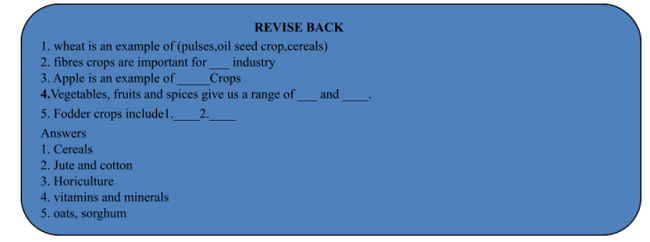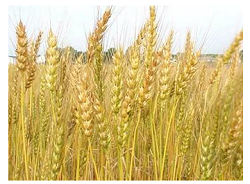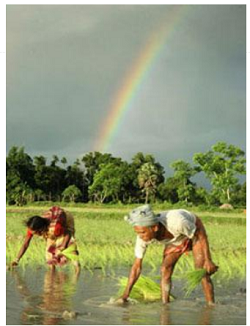TYPES OF CROPS
Improvement of food resources of Class 9
TYPES OF CROPS
The crops are classified on the basis of commerce or climate as follows:
COMMERCIAL CLASSIFICATION:
It is based on the trade and commerce of agricultural produce.
Food crops:
They include rice, wheat, maize pulses, oil seeds, vegetables, etc.
- The cereals such as wheat, rice, maize, barley, etc provide us carbohydrates which give us energy.
- Pulses such as gram, pea, black gram (urad), green gram (moong), etc give us protein.
- Oil seeds such as soyabean, ground nut, castor, seasame, etc, give us fat.
- Vegetables, fruits and spices give us a range of vitamins and minerals.
Fodder crops:
These include oats, sorghum, etc, which are raised as food for the livestock.
Cash crops:
These include cotton, sugarcane, sugar beet, tobacco, etc.
Table: Classification of crop plants
|
Type of crop plant |
Examples |
Importance |
|
1. Cereals |
Wheat, Rice, Maize, MinorMillets, Sorghum |
Rich in carbohydrates for energyRequirements. |
|
2. Pulses |
Gram(Chana), Pea (Matar)Black Gram (Moong), PigeonPea (Arhar), Lentil (Masoor)Etc. |
Rice in proteins that are body Builders. |
|
3. Oil seed crops |
Soybean, GroundnutSunflower, Niger, Sesame,Castor, Mustard, Linseed. |
Rice in oils and fatty acid |
|
4. Root crops |
Turnip, Carrot, Turmeric, SweetPotato & Ginger |
It is utitized as the vegetables & medicines |
|
5. Sugar crops |
Sugarcane And Beet |
Important for wine industry. |
|
6. Fibre crops |
Jute & Cotton |
Important for jute & cotton industry. |
|
7. Plantation crops |
Tea, Coffee, Coconut AndRubber |
Increases case and also called as Case crops. |
|
8. Fodder crops |
Berseem, Maize, Sorghum AndElephant Grass. |
Provide fodder for animals |
|
9. Horiculture crops (Fruits and vegetables) |
Apple, Banana, Guava,Pomegranate, Pears, Chilies,Coriander, Jeera, Carrot, Raddish, Cabbage, Caulifiower, Spinach, Cucurbit. |
Provide vitamins, minerals along withSmall three quantities of Carbohydrates, proteins and oils. |
CLIMATIC CLASSIFICATION:
Crops are also classified on the basis of climatic requirements like specific temperature, humidity, photoperiods, etc. Different crops require different climatic conditions. Some grow in winters and others in summers. Duration of light period during the day time affects several processes like photosynthesis, growth and morphogenesis.
On the basis of seasonal variations, the crops of India can be classified as :
|
Wheat crop
|
|
|
Paddy crop |
|
Zaid : It is a summer season crop grown from April to June. Cucumbers, melons, etc are zaid crops.
|
Kharif crop/ Rainy season crop |
Rabi crop/ Winter season drop |
|
|
|
|
|
|
|
|

Related Topics
- Introduction to Improvement of food resources
- Sustainable agriculture
- TYPES OF CROPS
- IMPROVEMENT IN CROP YIELD
- MANURES & FERTILISERS
- BIOFERTILIZERS
- STORAGE OF GRAINS
- ANIMAL HUSBANDRY
- solved question
- Exercise 1
- Exercise 2(Fill in the blanks)
- Exercise 3 (Subjective) Improvement of food resources
- Exercise 4 (Subjective) Improvement of food resources
- Exercise 5 (True -False) Improvement of food resources











